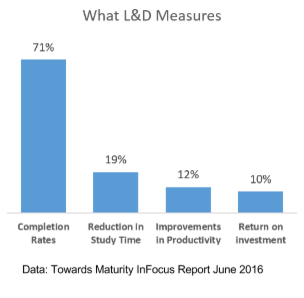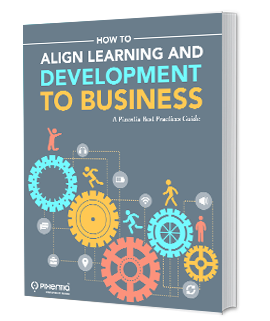
If you are a Learning and Development leader struggling with providing the reports your managers, executives, and employees need, you are not alone. The June 2016 Towards Maturity InFocus report “Making an Impact” shows us that while 96% of respondents want to report on business impact, only 17% are doing it. Seventy-one percent of respondents  measure course completion rates, but only 10% know what return they are getting on their investment.
measure course completion rates, but only 10% know what return they are getting on their investment.
CEOs care about performance, and if L&D can’t show the impact of training on performance, executives are right to question its value. And when we read the details of the report, we come away with the conclusion that in spite of improvements in recent years, most L&D organizations are not aligned with the business.
- 55% analyze the business problem before recommending a solution.
- 31% identify the KPI’s that they want to achieve up front, with senior managers in the business.
- 36% have a plan for how they will meet the agreed business metrics/KPI’s.
- 17% measure specific business metrics when evaluating the effectiveness of learning technologies.
In our blog series about aligning learning to the business, strategic alignment is the starting point for an effective L&D organization, but making it happen is difficult. How do you begin when you are buried in smiley sheets, Excel workbooks, and manual reports? What do you do when your LMS can’t give you the information you need, and even if it does, your staff doesn’t know how to use it?
Let’s take a step back and look at the familiar Kirkpatrick learning  measurement model, which Kirkpatrick Partners now describes as a “chain of evidence to link results at each level.” It asks us to answer these questions:
measurement model, which Kirkpatrick Partners now describes as a “chain of evidence to link results at each level.” It asks us to answer these questions:
- Did learners find it useful and relevant?
- Did participants acquire the knowledge?
- Did behavior change on the job?
- Did targeted outcomes occur?
At each successive level, measurement is more difficult but also more important to business leaders. Your CEO probably does not care about reaction, learning, or behavior unless it impacts the business.
Plan of Action
What does this mean to the CLO struggling to measure learning in a useful way? First, you have lots of company. Almost all organizations can measure only at level 1. Some can measure Level 2, but few can assess learning at levels 3 and 4.
Second, you can’t achieve excellence in learning measurement without a structured plan, support from line-of-business leaders, and the technology to enable it.
Let’s outline a plan and how you can get the support to implement it.
Define the Need
We would begin by clearly stating the problem. Stating that you currently do not have the capability to report on business impact is the starting point.
Form Alliances
Partner with your CHRO, CIO, and CFO to assess the current situation.
What is the state of reporting and analytics in the organization? Is there an analytics strategy? What is L&D’s place in it?
Does your organization have a data governance policy? Is there a data governance body managing organization-wide data management?
The answers to these questions will guide your next steps. If your organization provides the framework for you to develop your reporting capability, you will need to define your needs and help to prioritize them. If not, a lack of good governance may be an opportunity to influence better practices. Lastly, a completely siloed organization may indicate that you need to work within the limits of your influence.
Align to the Business
Partnering with line-of-business leaders may be easier than you think. Aligning with the business starts with asking the right questions when a need arises.
As we saw in the Towards Maturity study, too few L&D organizations analyze a business problem before they design an intervention, and that is the place where alignment and partnership start.
Change the conversation by asking your business partners to help you define the business need. Ask them how it fits into the strategic plan and how they measure results. Position yourself as a consulting partner who will help them meet their objectives. Make the conversation about improving their results.
Work with your business partner to quantify how the proposed solution will impact their performance. This creates a fundamental shift in thinking. Now, instead of being an L&D problem, measurement becomes a function of business operations.
Get Control of Operational Reporting
Before any L&D organization can move beyond the basics to measure impact, it must get control of operational reporting and automate measurement levels 1 and 2. It is hard to rise above the fray to a better vision if you are mired in paperwork and Excel spreadsheets.
Of the over 700 LMS providers in the market, few can report on more than learning events, and reporting is not flexible in many of them. Of the top tier vendors, all have excellent reporting tools, but managing them well is not for novices. It takes time to learn how to use them.
If you don’t have the expertise to manage automated reporting, you have the build, buy, or rent decision to make. You can upskill your staff through training or hiring, or you can partner with an analytics consulting firm until you build your capability. Or you may find the expertise hidden within your organization.
If your current technology is holding you back, it may be time for a change. On the other hand, you may only need to make a few adjustments to get what you need. Our next article will help you through the assessment of your technology to build a foundation for L&D reporting.
Pixentia is a full-service technology company dedicated to helping clients solve business problems, improve the capability of their people, and achieve better results.



